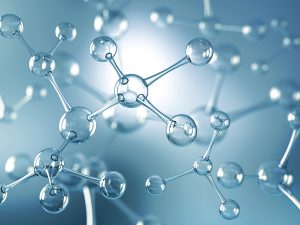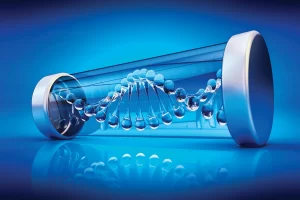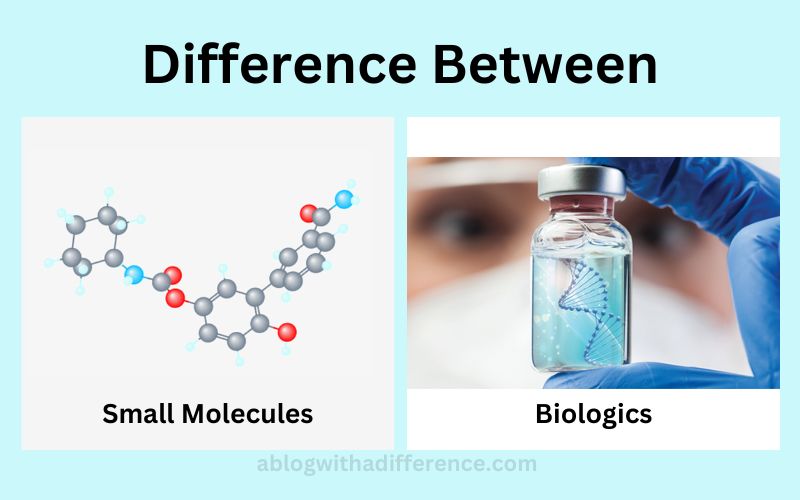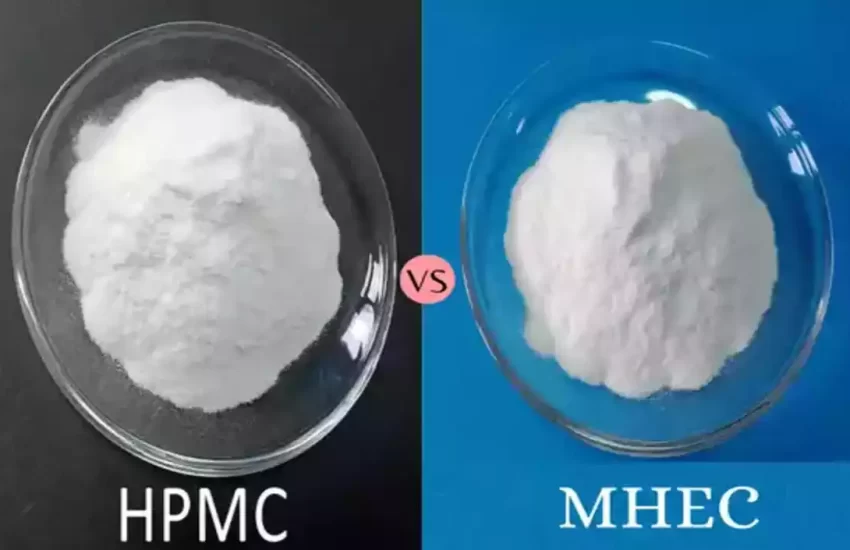Difference Between Small Molecules and Biologics
An Overview of Small Molecules and Biologics
Small Molecules and Biologics comprise two classes of drugs which differ based on chemical composition, manufacturing process and mode of action.
Small molecules are manufactured chemically and possess molecular weights under 900 Daltons, and can enter cells easily for intracellular communication purposes. Small molecules are often utilized as treatments for conditions such as infections, cancer and cardiovascular issues.
Biologics, on the other hand, are large complex molecules produced by living organisms consisting of proteins and antibodies produced against specific targets; such as extracellular targets. Biologics injections may be administered and targeted at extracellular targets for use as treatments against conditions like autoimmune disorders, cancer or rare genetic disorders.
Biologics and small molecules both undergo distinct discovery and development processes, with differing pharmacokinetic and pharmacodynamic profiles; consequently, choosing an ideal medication depends on both these qualities and your patients’ specific clinical requirements.
Importance of understanding the differences between Small Molecules and Biologics
Understanding the differences between Biologics and Small Molecules is of vital importance for several reasons, including:
- Manufacturing and Development: The composition and manufacturing methods for biologics and small molecules require different knowledge, expertise, and equipment for safe production of medicines. Understanding this fact is imperative to effective drug manufacturing and development processes.
- Clinical Factors: Small molecules and biologics each possess distinctive pharmacokinetic and pharmacodynamic properties which impact their safety, effectiveness and dosing schedule. Understanding these differences is paramount in selecting an ideal medication for specific clinical indications or populations of patients.
- Regulation Considerations: “Biomedicals and small molecules are subject to various regulations administered by regulatory authorities such as FDA. Understanding their specific requirements is vital for successful drug development and approval.”
- Intellectual Property: Biotech and small molecule products each possess specific patenting strategies and protection timelines that must be recognized to safeguard intellectual property as well as guarantee exclusive market access.
Knowing the distinctions between biologics and small molecules is of vital importance when it comes to effective manufacturing, development and clinical trial usage.
What exactly are small molecules?
Small molecules have long been an integral component of drug discovery and development processes, including those using classical formulation techniques such as using active substances with smaller molecular weights as primary ingredients.

Aspirin contains the active component Acetylsalicylic acid a small molecule capable of entering your bloodstream easily via your intestinal wall.
After this step is taken, molecules will be able to reach their targets for treatment. Their compact structures and chemical composition that allows them to pass easily into cell membranes.
Small molecules can be synthesized using organic or inorganic chemical reactions to generate small quantities in an experiment in a lab environment for research purposes.
What exactly are Biologics?
Biologics also referred to as Biopharmaceuticals or biologicals are large molecules such as proteins that exert biological effects on the Human body. Another term commonly used to refer to them is Biologics. Biologics generally contain over one thousand amino acids per protein molecule and tend to become unstable at room temperature if left exposed for too long.
Biologics can bind with receptors on cell membranes that have been associated with particular illnesses, making them suitable for cancer therapy as well. We can administer this large molecule via injection or infusion for maximum effectiveness.
Oral administration of biological drugs isn’t ideal as stomach acid absorbs them quickly. Furthermore, protein engineering (the creation process used to produce biologics) takes place within living cells or organisms – not ideal when applied topically!

No matter the tools we employ, it remains impossible for us to accurately pinpoint their structures.
Difference Between Small Molecules and Biologics
Research and development of biologics and small molecules differ considerably:
- Target Identification: Determination of small-molecular targets can often be done through phenotypic screening techniques or the identification of small molecules which bind directly to them; while for biological targets identification usually involves detection of biomarkers associated with disease as well as assays to measure protein-protein interactions that reveal which proteins bind directly with specific targets.
- Lead Optimization: Small-molecule discovery typically entails optimizing individual small molecules to increase their effectiveness, selectivity and pharmacokinetic characteristics; while lead optimization for biologics involves creating and engineering proteins to enhance binding ability, stability as well as pharmacokinetic characteristics.
- Manufacturing: Small-molecule drugs can typically be created chemically and mass produced fairly simply; however biologics must be created from living cells using specific manufacturing procedures, including fermentation, purification and characterizing processes.
- Regulatory approval: Small biomolecules as well as biologics must undergo different approval processes from regulatory authorities such as the FDA for approval purposes, while small-molecule drugs usually fall under an application for new drug (NDA) process, while biologics require approval via their biologic license application process (BLA).
- Intellectual Property: Small molecule drugs tend to be protected with patents on chemical composition while biologics typically fall under protection via process and product patents, with additional market exclusivity granted from regulatory exclusivity agreements for biologics.
Development and discovery of biologics and small molecules differ drastically, reflecting differences in chemical composition, manufacturing requirements and regulatory demands.
Differences in Pharmacokinetics and Pharmacodynamics
Pharmacokinetics and pharmacodynamics of small molecules and biologics vary considerably:
- Absorption: Small molecules tend to be oral bioavailable and easily absorbed through the digestive tract, while biologics require injection and are quickly distributed throughout the lymphatic system and bloodstream for absorption.
- Distribution: Small molecules can easily navigate their way throughout the body via blood circulation, crossing cell membranes to reach intracellular targets; however, biologics typically remain extracellular and cannot pass through cell membranes to reach intracellular ones.
- Metabolism: Small molecules tend to be processed by the liver or other organs while biotechnological products typically leave our bodies via lymphatic systems or kidneys.
- Half-life: Small molecules tend to have shorter half-lives than biologics due to being processed more rapidly out of the body.
- Target Specificity: Small molecules have the capability of binding with multiple targets while biologics tend to be very specific in targeting their desired receptors or proteins, making treatment much less likely to interact with unrelated ones.
- Immune response: An immune reaction may prompt neutralizing antibodies to form; however, small molecules cannot induce such a response.
Pharmacokinetics and pharmacodynamics of smaller molecules and biologics vary due to differences in chemical composition, method of administration and interactions with biochemical systems in your body.
These differences may impact safety, efficacy and dosing schedules of medicines designed for specific indications or patient populations and should be carefully considered when selecting suitable medication treatments for them.
Examples of Small Molecule and Biologic Drugs
Examples of small-molecule drugs include:
- Aspirin: Small molecule drugs include Aspirin as an anti-inflammatory and pain relief agent.
- Atorvastatin (Lipitor): is prescribed to reduce cholesterol levels.
- Ibuprofen: acts as both an anti Inflammatory agent and pain reliever.
- Metformin (Glucophage): Used for treating type 2 diabetes.
- Omeprazole (Prilosec): Prescribed to treat gastroesophageal resuscitation disorder (GERD) or ulcers caused by peptic issues.
Examples of biologic drugs include:
- Adalimumab (Humira): is a monoclonal Antibody medication prescribed to treat various autoimmune conditions like arthritis and psoriasis.
- Insulin: provides treatment for diabetes.
- Rituximab (Rituxan): a monoclonal antibody to treat autoimmune diseases and cancer.
- Erythropoietin: It’s used to increase red blood cells production among anemia patients.
- Infliximab (Remicade): for example, is used to treat Crohn’s disease or ulcerative colitis autoimmune conditions.
These examples illustrate the various therapeutic uses for small molecules and biologic drugs as well as their distinct actions and administration methods.
Comparative Table of Small Molecules and Biologics
Here’s a chart of comparison that outlines the main differences between small molecules as well as biologics:
| Characteristics | Small Molecules | Biologics |
|---|---|---|
| Chemical Composition | Semi-synthetic or synthetic | Produced with living cells |
| Modality of Administration | Topical, oral or inhalation | Infusions or injections |
| Discovery and Development | High-throughput screening | Assays based on cells and animal models |
| Half-life | Short | Long |
| Metabolism | Liver and various organs | Kidneys and lymphatic system |
| Target Specificity | It could bind to a variety of targets | Very specific to the targets |
| Immune Response | Rarely trigger an immune response | Inducing immune responses that includes neutralizing antibodies |
| Therapeutic Applications | A wide range of therapeutic applications such as pain relief as well as diabetes inflammation and even cancer | Primarily, it is used for treating autoimmune diseases as well as cancer and genetic disorders |
This chart gives a brief overview of some of the most important distinctions between biologics and small molecules in relation to the chemical makeup, modes of administration as well as discovery and development of pharmaceutical pharmacokinetics, pharmacodynamics, as well as therapeutic applications.
Both smaller molecules as well as biologics play crucial functions in modern medicine, and understanding the differences between them can aid researchers and clinicians determine the appropriate medication for a specific condition and patient group.
Conclusion
Biologics and small molecules represent two separate classes of drugs with distinct chemical makeups, processes for development, discoveries as well as different mechanisms of action including pharmacokinetics/pharmacodynamics as well as therapeutic uses.
Small molecules are produced chemically and made bioavailable, while biologics consist of living cells made up from injection.
With regards to digestion in the liver and shorter half-lives than biologics; small-molecule drugs tend to attach themselves more readily with multiple targets than their biologic counterparts.
But biologics tend to leave your body through lymphatic systems or kidneys with longer half-lives and greater target specificity than small molecules do.
Therefore, understanding these differences between biologics and small molecules is integral for drug discovery, development and finding suitable remedies for specific medical indications or patients.


